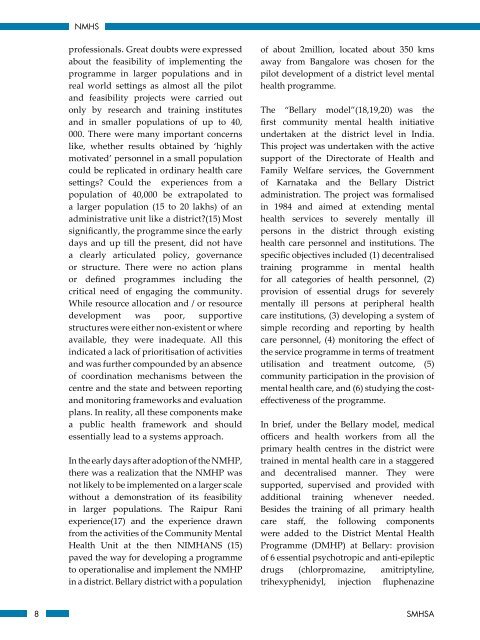National Mental Health Survey of India 2015-16
NMHS%20Report%20%28Mental%20Health%20Systems%29%201
NMHS%20Report%20%28Mental%20Health%20Systems%29%201
You also want an ePaper? Increase the reach of your titles
YUMPU automatically turns print PDFs into web optimized ePapers that Google loves.
NMHS<br />
pr<strong>of</strong>essionals. Great doubts were expressed<br />
about the feasibility <strong>of</strong> implementing the<br />
programme in larger populations and in<br />
real world settings as almost all the pilot<br />
and feasibility projects were carried out<br />
only by research and training institutes<br />
and in smaller populations <strong>of</strong> up to 40,<br />
000. There were many important concerns<br />
like, whether results obtained by ‘highly<br />
motivated’ personnel in a small population<br />
could be replicated in ordinary health care<br />
settings? Could the experiences from a<br />
population <strong>of</strong> 40,000 be extrapolated to<br />
a larger population (15 to 20 lakhs) <strong>of</strong> an<br />
administrative unit like a district?(15) Most<br />
significantly, the programme since the early<br />
days and up till the present, did not have<br />
a clearly articulated policy, governance<br />
or structure. There were no action plans<br />
or defined programmes including the<br />
critical need <strong>of</strong> engaging the community.<br />
While resource allocation and / or resource<br />
development was poor, supportive<br />
structures were either non-existent or where<br />
available, they were inadequate. All this<br />
indicated a lack <strong>of</strong> prioritisation <strong>of</strong> activities<br />
and was further compounded by an absence<br />
<strong>of</strong> coordination mechanisms between the<br />
centre and the state and between reporting<br />
and monitoring frameworks and evaluation<br />
plans. In reality, all these components make<br />
a public health framework and should<br />
essentially lead to a systems approach.<br />
In the early days after adoption <strong>of</strong> the NMHP,<br />
there was a realization that the NMHP was<br />
not likely to be implemented on a larger scale<br />
without a demonstration <strong>of</strong> its feasibility<br />
in larger populations. The Raipur Rani<br />
experience(17) and the experience drawn<br />
from the activities <strong>of</strong> the Community <strong>Mental</strong><br />
<strong>Health</strong> Unit at the then NIMHANS (15)<br />
paved the way for developing a programme<br />
to operationalise and implement the NMHP<br />
in a district. Bellary district with a population<br />
<strong>of</strong> about 2million, located about 350 kms<br />
away from Bangalore was chosen for the<br />
pilot development <strong>of</strong> a district level mental<br />
health programme.<br />
The “Bellary model”(18,19,20) was the<br />
first community mental health initiative<br />
undertaken at the district level in <strong>India</strong>.<br />
This project was undertaken with the active<br />
support <strong>of</strong> the Directorate <strong>of</strong> <strong>Health</strong> and<br />
Family Welfare services, the Government<br />
<strong>of</strong> Karnataka and the Bellary District<br />
administration. The project was formalised<br />
in 1984 and aimed at extending mental<br />
health services to severely mentally ill<br />
persons in the district through existing<br />
health care personnel and institutions. The<br />
specific objectives included (1) decentralised<br />
training programme in mental health<br />
for all categories <strong>of</strong> health personnel, (2)<br />
provision <strong>of</strong> essential drugs for severely<br />
mentally ill persons at peripheral health<br />
care institutions, (3) developing a system <strong>of</strong><br />
simple recording and reporting by health<br />
care personnel, (4) monitoring the effect <strong>of</strong><br />
the service programme in terms <strong>of</strong> treatment<br />
utilisation and treatment outcome, (5)<br />
community participation in the provision <strong>of</strong><br />
mental health care, and (6) studying the costeffectiveness<br />
<strong>of</strong> the programme.<br />
In brief, under the Bellary model, medical<br />
<strong>of</strong>ficers and health workers from all the<br />
primary health centres in the district were<br />
trained in mental health care in a staggered<br />
and decentralised manner. They were<br />
supported, supervised and provided with<br />
additional training whenever needed.<br />
Besides the training <strong>of</strong> all primary health<br />
care staff, the following components<br />
were added to the District <strong>Mental</strong> <strong>Health</strong><br />
Programme (DMHP) at Bellary: provision<br />
<strong>of</strong> 6 essential psychotropic and anti-epileptic<br />
drugs (chlorpromazine, amitriptyline,<br />
trihexyphenidyl, injection fluphenazine<br />
8<br />
SMHSA


